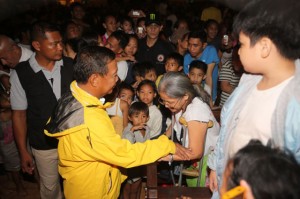STORM Mario (international name: Fung-Wong) not only left dozens of communities under water since it dumped record rainfall on Friday, it also washed out numerous roads in Metro Manila and in several provinces, according to the Department of Public Works and Highways (DPWH).
Based on an initial executive summary report, the DPWH on Saturday said at least 26 road sections were closed to traffic because of massive floodings—one in the National Capital Region (NCR); seven in the Cordillera Administrative Region (CAR); nine in Region 1; five in Region 3; one in Region 4-A; one in Region 4-B and two in Region 5.
In Metro Manila, the DPWH said the M.H. Del Pilar road in Valenzuela City was closed to traffic. The Arkong Bato road to Polo Bridge and Polo Bridge to Malanday were also closed.
The agency said these roads had to be closed because they were either washed out or damaged by landslides and flood waters.
The DPWH estimated that damage to roads and bridges in three regions could hit P100 million.
Based on the partial report of the DPWH’s Bureau of Maintenance, P91.10 million worth of roads were damaged by the storm.
The biggest damage was recorded in Region 3 at P56.60 million, followed by the Cordillera Administrative Region (CAR) at P31.50 million, and Region 1 at P3 million.
In the CAR, the damaged roads include the Abra-Ilocos Sur Road (Abra); Kennon Road, Benguet-Vizcaya Rd., Guisset Section, and Bokod Kabayan Rd., Bila Section (Benguet I); Baguio-Bontoc Rd., Pakpakitan Section (Benguet II); Quirino Highway (Baguio-Bauang Rd.), Irisan Section (Baguio City) and Banaue-Mayoyao Road, Kinakin Section (Ifugao II).
The impassable roads in Region I are the Manila North Road, Tabbog Br. (Ilocos Norte II); Manila North Road, Narvacan Jct., Manila North Road (MNR), Maynganay, Sta. Maria Town Proper, Manila North Road (MNR), Candon City (Ilocos Sur II); Luna Bangar Rd.
(La Union I); Bauang-Baguio City Road Ribsuan Bridge (La Union II); Pangasinan-Tarlac Road, Quiray Bridge in Aguilar, Pangasinan (Pangasinan II); Urdaneta Jct.-Dagupan Road (Pangasinan III) and Camiling-Wawa-Bayambang Malasiqui-Sta. Barbara Road and Sapang Bridge (Pangasinan IV).
The roads that were closed in Region 3 are the Nueva Ecija-Pangasinan Road, Brgy. Sabit Cuyapo, Nueva Ecija and Munoz-Lupao Road (Nueva Ecija I); Bigaa Plaridel Road, Panginay, Balagtas (Bulacan I); Baliwag-Candaba-Sta. Ana Road, Brgy. Paralaya, Candaba and Candaba-San Miguel Rd. (Pampanga I).
Also closed were the Bauan Mabini Road, Batangas II, (Region IV-A); Pola Spillway, Brgy. Barahan, Sta Cruz, Occidental Mindoro (Region IV-B); Daang Maharlika, Cabuluan Detour Bridge, Sta. Elena, Camarines Norte; and Jct. Panganiban-Saloyon Road, Mosocbosoc Br., Brgy Sablayan, Caramoran, Catanduanes (Region V).
The DPWH said temporary foot bridges were constructed in Nueva Ecija. It added that crew had been deployed to declog flooded roads and install warning signs in flooded road sections.
9 dead
Mario also left at least nine people dead and affected more than half a million others.
The fatalities were identified as Althea Gaviola, 2, of Bagong Silangan, Quezon City; Erlinda Centeno, 69 of Montalban Heights, Rodriquez, Rizal; Tomas Prino Barol, 31, of Barangay Villaflores, Sta. Fe, Nueva Vizcaya; Javier Jevania Mateo, a month-old infant, Barangay Sto. Domingo, Piat, Cagayan; Jar-Ar Taganas, 34 of Barangay Apolonio Samson, Quezon City; and Benedicto Glendon Sol, 22, Sampaloc, Manila.
National Disaster Risk Reduction and Management Council (NDRRMC) executive director Alexander Pama said the seventh fatality was a 22-year-old man from Cubao, Quezon City whose identity was withheld upon request of the family.
Two other victims drowned in their village in Camarines Sur – Eduardo Lelis, 60 and Conrado Bergonio, 61.
The NDRRMC report added that at least 118,839 families, or 530,438 people, were displaced by the storm. Of these, 23,581 families, or 93,052 persons, remained in 181 evacuation centers.
Meanwhile, the Philippine Coast Guard said 1,796 passengers were stranded in ports throughout Southern Tagalog and the Visayas as of early Saturday morning.
In Marikina City, the water level at the Marikina River, which rose to critical levels and prompted the forced evacuation of thousands of residents on Friday, receded yesterday morning. The city government said 8,311 families, or 36,027 people remained in 39 evacuation centers.
Storm Mario intensified on Saturday as it headed to southern Taiwan. At 4 p.m. yesterday, it was 203 km north northwest of Laoag City packing maximum sustained winds of 105 kph near the center and gustiness of up to 135 kph. It is forecast to move north northeast at 17 kph.
A state of calamity was declared in Ilocos Norte, one of the provinces battered by the storm.
The Philippine Red Cross (PRC) said it continues to help victims who sought shelter in evacuation centers.
PRC Chairman Richard Gordon said they rescued over 600 people, including assisting pregnant women who were about to give birth.
Gordon said hot meals and drinking water were given to over 6,000 people in evacuation centers in the cities of Quezon, Manila, Pasay and Valenzuela.
He added that welfare desks and first aid stations were also put up so that residents who need medical attention can be cared for by volunteer doctors and nurses.
PRC secretary general Gwendolyn Pang said communities affected by storm Mario “will receive our assistance and support long after this typhoon has passed.”
She said they deployed social workers to man 13 welfare desks to deliver psychosocial support program.


